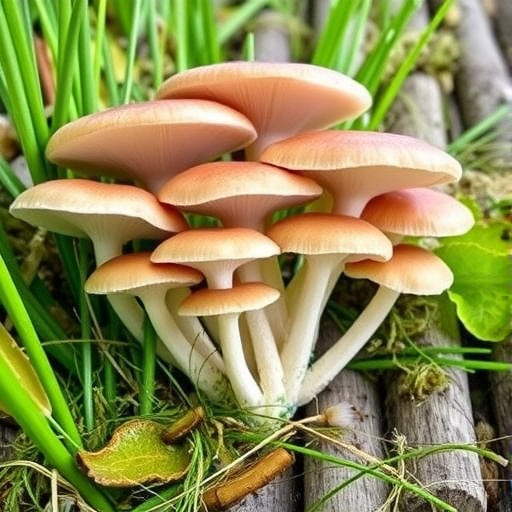
In an era where sustainable agriculture is more crucial than ever, innovative approaches continue to emerge, reshaping our understanding of crop production methods. One such groundbreaking technique is the utilization of Jaragua grass (Hyparrhenia rufa) as an alternative substrate for cultivating oyster mushrooms (Pleurotus ostreatus). This intriguing study, conducted by a team of researchers led by Haftu, Abera, and Weleabzgi, has the potential to revolutionize mushroom cultivation while promoting environmental sustainability.
The increasing demand for oyster mushrooms, known for their culinary versatility and health benefits, poses a significant challenge for traditional agricultural practices. As the global population continues to rise, so does the need for efficient food production methods that do not compromise the integrity of our ecosystems. This research highlights the potential of Jaragua grass not only as an economically viable substrate but also as a sustainable solution to meet the burgeoning demand for mushrooms.
Jaragua grass is a perennial grass native to tropical regions, praised for its rapid growth and high biomass yield. Traditionally, agricultural waste and wood residues have been employed in mushroom cultivation, but these options often come with their own set of challenges, including availability and sustainability. The introduction of Jaragua grass opens up new avenues for minimizing waste and maximizing production efficiency, thereby aligning with the principles of sustainable agriculture.
The researchers initiated their investigation by analyzing the physical and chemical properties of Jaragua grass to determine its suitability as a substrate for oyster mushroom cultivation. They aimed to explore the grass’s lignocellulosic composition, moisture content, and nutrient profile. By leveraging these characteristics, they could ascertain how Jaragua grass could support the growth and yield of Pleurotus ostreatus, a mushroom variant known for its adaptability to various substrates.
The findings from the study revealed that Jaragua grass possesses an optimal balance of carbon to nitrogen, making it a conducive environment for mycelial growth. The nutrient availability within the grass was found to enhance the proliferation of oyster mushrooms, leading to increased yields when compared to conventional substrates. This critical understanding is key to developing more efficient mushroom production systems that utilize non-traditional materials without sacrificing quality.
Additionally, the researchers conducted a series of trials to evaluate the growth performance of oyster mushrooms grown on Jaragua grass. These trials aimed to identify the optimal conditions for cultivating mushrooms, including variations in moisture, temperature, and supplementation. The results showcased that, under the right conditions, Jaragua grass significantly enhances the growth rate and overall biomass of Pleurotus ostreatus, thus presenting a viable alternative to traditional substrates.
The implications of using Jaragua grass extend beyond just enhancing yield. This research points towards a holistic approach to farming by integrating waste management and agricultural productivity. By repurposing Jaragua grass — often viewed as a weed in some regions — farmers can contribute to a circular economy, reducing reliance on synthetic fertilizers and non-renewable resources. This shift could potentially lead to lower production costs and increased profitability for mushroom farmers.
In terms of environmental impact, the use of Jaragua grass as a substrate could significantly reduce the carbon footprint associated with mushroom production. Traditional substrates such as sawdust or straw often require extensive processing and transport, contributing to greenhouse gas emissions. In contrast, cultivating mushrooms on locally-sourced Jaragua grass promotes resource efficiency and lowers transportation emissions, making it an eco-friendlier option.
Furthermore, integrating Jaragua grass into existing mushroom cultivation practices could enhance soil health. The residues generated during the mushroom cultivation process can be returned to the soil, enriching its nutrient profile and fostering a sustainable agricultural cycle. This approach not only supports mushroom production but also contributes positively to the surrounding ecosystem, promoting biodiversity and soil fertility.
As the research progresses, it is essential to convey the practical implications of these findings to farmers and agricultural stakeholders. Education and dissemination of knowledge about sustainable practices are vital to ensure that such innovations take root in the industry. Workshops and field demonstrations could effectively illustrate the benefits of using Jaragua grass, encouraging farmers to adopt these techniques in their operations.
This study positions Jaragua grass as a significant player in the realm of sustainable agriculture, particularly in mushroom cultivation. By recognizing the potential of this local resource, farmers can enhance their production methods while simultaneously reducing environmental impact. Such research not only paves the way for innovative agricultural practices but also inspires a new generation of environmentally conscious farmers and consumers alike.
In conclusion, the exploration of Jaragua grass as an alternative substrate for oyster mushroom cultivation has opened up new avenues in sustainable agriculture. The findings of Haftu, Abera, and Weleabzgi reveal that not only can we enhance mushroom yields, but we can also promote environmental sustainability by utilizing locally available resources. As the agricultural landscape continually evolves, embracing such innovative practices will be essential in meeting the challenges of food security and ecological preservation in the years to come.
The future is bright for those willing to rethink traditional agricultural practices, and the utilization of Jaragua grass represents a small, yet significant step towards a more sustainable and efficient agricultural system. With continued research and practical implementation, we can look forward to a future where agricultural innovation and environmental stewardship go hand in hand, embodying the very essence of sustainable development.
Subject of Research: Utilization of Jaragua grass as substrate for oyster mushroom cultivation
Article Title: Utilization of Jaragua grass (Hyparrhenia rufa) as alternative substrate for oyster mushroom (Pleurotus ostreatus) cultivation.
Article References:
Haftu, S.Z., Abera, H.K., Weleabzgi, K.W. et al. Utilization of Jaragua grass (Hyparrhenia rufa) as alternative substrate for oyster mushroom (Pleurotus ostreatus) cultivation. Discov Agric 3, 131 (2025). https://doi.org/10.1007/s44279-025-00313-5
Image Credits: AI Generated
DOI: 10.1007/s44279-025-00313-5
Keywords: Jaragua grass, oyster mushroom cultivation, sustainable agriculture, alternative substrates, environmental impact
Tags: agricultural waste alternativeschallenges in traditional mushroom substrateseconomic viability of Jaragua grassefficient food production solutionsenvironmental sustainability in farminginnovative mushroom farming methodsJaragua grass alternative substrateoyster mushroom cultivation techniquesPleurotus ostreatus productionsustainable agriculture practicessustainable mushroom farmingtropical perennial grasses for farming




